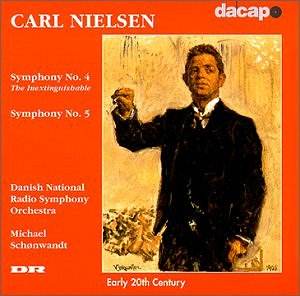NIELSEN
Symphony no. 4 'The Inextinguishable'
Symphony no. 5
 Danish National Radio Symphony
Orchestra
Danish National Radio Symphony
Orchestra
Michael Schønwandt
 Dacapo 8 224156 (76
minutes)
Dacapo 8 224156 (76
minutes)
Crotchet
Amazon
UK

Nielsen is one of the great symphonists, and these two symphonies are arguably
his finest. Here they are coupled in a modern recording, with a top class
orchestra which has probably performed the music more often than any other.
So far so good, then. And it is true that there are commendable aspects to
this production. The recording is nicely balanced in a clear and ambient
acoustic, while the performances are nicely balanced too. But in a competitive
market these attributes aren't necessarily enough.
Both these works can be described as 'conflict symphonies', in which elemental
forces and ideas do battle, as graphically represented by the pair of timpani
in the finale of the Fourth and the side-drum solo in the first movement
of the Fifth. Therefore the opportunity for real symphonic drama is strongly
present. Schønwandt misses it. His performances are sensitive to phrasing
and line, certainly, but they don't have the cutting edge that others have
found, most notably Herbert Blomstedt and the San Fransisco Symphony Orchestra.
The first movement of the Inextinguishable is suitably vital, but as the
music proceeds, the strings sound somewhat undernourished and the music loses
power as a result. The second movement is very lightweight, though the great
finale, with its warring pair of timpani most effectively captured in the
recorded perspective, is very effective.
In the Fifth the role of the percussion is particularly crucial in the first
movement. Though the performance is well paced and there are some memorable
solos from the clarinet, overall the balance is too polite, the drama lacking
focus. The great side drum attack, when the player is instructed to 'improvise,
as if at all costs to prevent the progress of the remainder of the orchestra',
is under-characterised, both in its symphonic context and its particular
effect. The second movement (there are two large movements) is notable for
its strength and the bounding energy generated by the powerful sweep of the
opening theme. Schønwandt's tempo is rather dogged here, not necessarily
a bad thing on itself, but it does pose problems of momentum as the music
develops. In particular the sweep of compelling elemental energy isn't quite
as compelling as it might be, especially when the symphony reaches its blazing
final phase.
Terry Barfoot
